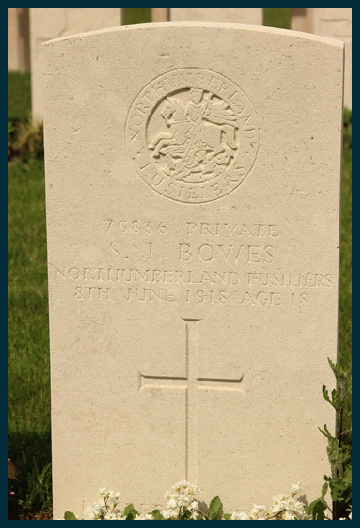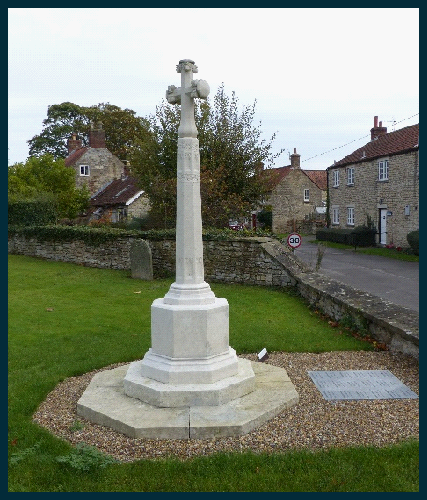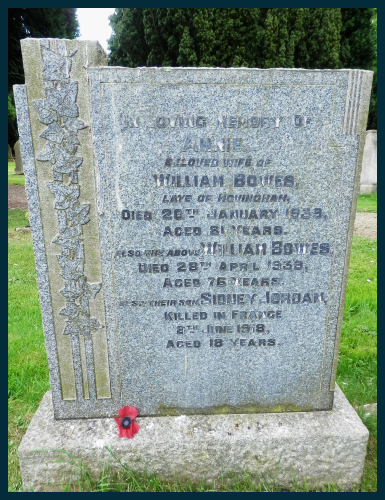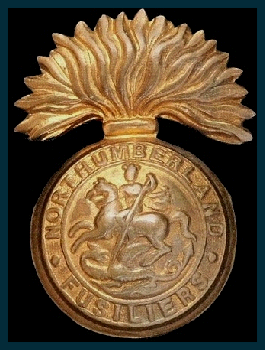Copyright © All rights reserved.



Sidney Jordan Bowes
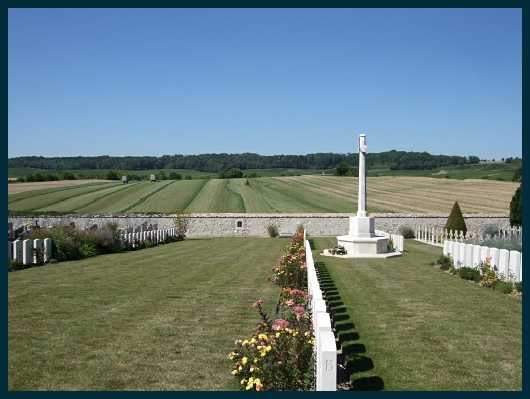
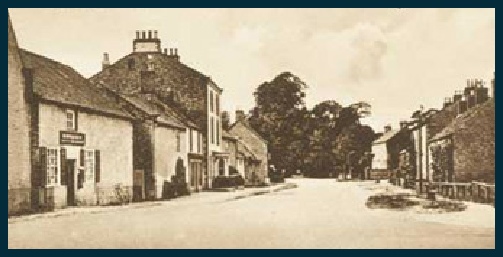
Sidney Jordan Bowes was the only surviving son of William and Ann (nee Stevens) Bowes who married in the second quarter of 1895 in the Stokesley area. Ann was from Chilmark on Salisbury Plain, and she and William presumably met while she was working as a domestic servant for the Morton family in Scackleton. William’s father was a farmer on a small scale (about 12 acres) in Hovingham.
Sidney was born in the third quarter of 1899. The 1911 census shows that he had a sibling who had died before 1911 and as there is no indication of any other child in the census it is likely that it was very short-
In 1901 the family was living in Hovingham – unfortunately the census gives no detail of exactly where but it may well have been on Park Street.
1901 Census -
William Bowes, Head, Married, Male, 38, Hovingham, Yorkshire, Farmer,
Ann Bowes, Wife, Married, Female, 43, Wiltshire, -
Sidney J. Bowes, Son, -
Given that he is commemorated in Malton School it would seem that he went on to the Grammar school in Malton from the village school in Hovingham probably around 1911.
1911 census -
William Bowes, Head, Married, Male, 48, Hovingham Yorkshire, Farmer,
Annie Bowes, Wife, Married, Female, 52, Chilmark Wiltshire, -
Sidney Jordan Bowes, Son, Single, Male, 11, Hovingham Yorks, School,
Gordon Russell Pavier, Boarder, Single, Male, 25, Heaton Chapel, Lancs, Farm Student,
Douglas Peirse, Boarder, Single, Male, 21, Aughton Lancs, Farm Student,
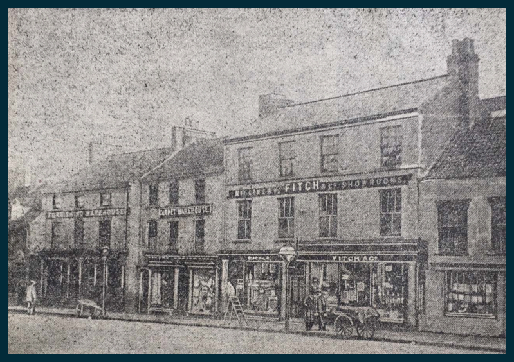
Before the war Sidney was working at Messrs Fitch & Co. a successful Drapers establishment on the Market Place, selling millinery, dresses, linen, silks, and general drapery, as well as carpets, linoleum, and all kinds of household furniture and employing about 60 workers. Presumably he started working there as an errand boy or something similar as at the outbreak of war he would have been about 14 years old.
He joined 1/5 Battalion Northumberland Fusiliers serving in XV Platoon, “D” Company and was probably sent to the Front in March 1918 when the age limit for service overseas was lowered from 19 to 18 years and six months. However he will have been called up about six months before that, and initially served in the 5th Training reserve Battalion of the regiment.
The 5th Battalion Northumberland Fusiliers formed part of 149th Brigade in the 50th (Northumbrian) Division. All the battalions in the division were territorials recruited from the north east and included the 5th Yorkshire Regiment from Malton and the surrounding area.
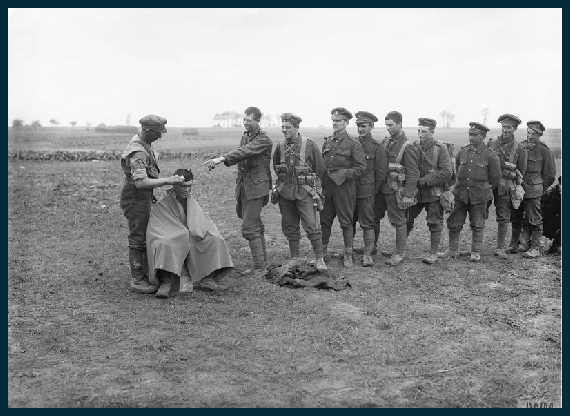
In early to mid-
On 25th May, the Battalion was relieved by 4th Battalion Northumberland Fusiliers & moved back into the Reserve. The following day was spent resting and cleaning up, the lull before the storm. At 6.30 that evening a message was received from Division to adopt precautionary defence measures, but the Battalion, being in Corps Reserve took no action. At 7.30 pm they were told that an enemy attack was expected at 3 am. to be preceded by bombardment. Half an hour later the battalion moved into Divisional Reserve, staying at Concevreux.
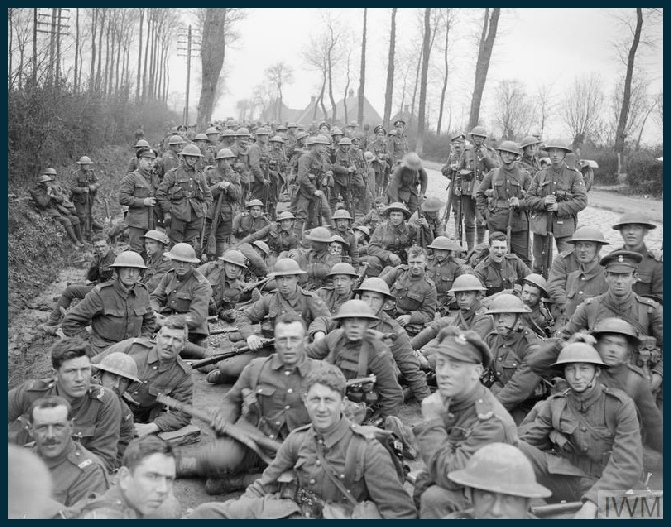
The 149th Brigade was in the line at Craonne near Rheims when the attack came at 1 am on 27th May, 3,719 German guns were used on a 24-
Almost immediately they ran into intense barrage and C Coy reported that they were unable to occupy the line owing to machine gun fire and the intense barrage. Meanwhile A & B Companies came under intense barrage and sustained heavy casualties and the entire line fell back initially to Chaudardes, and later, when the enemy brought heavy machine gun fire to bear on the left flank, to the canal bank.
By 2.30 pm they had withdrawn to the heights south of Concevereux where at 5.00 p.m the remainder of the Brigade took up a line on the heights between Meurival & Roucy -
By 6 am the following morning, the enemy had occupied Romain and the wooded heights east of stream and the line withdrew to fight a rearguard action to Vandeuil. The division's artillery brigades lost all of their guns and most of the men were captured when surrounded early in the day. Even the Division HQ at Beaurieux, was forced to move and had men captured from it. By the evening the 50th Division had lost 5,106 officers and men, killed wounded and missing. The remnant of the battalion continued to fight until 12 noon on the 29th, when a composite unit was formed of all the fighting men of the Division at Cuisles.
Next day this composite battalion was ordered to hold the high ground north east of Romigny. The rest of the Division was withdrawn on 31st May to Vert Ia Gravelle where it could muster only around 700 infantrymen. 1/5 Battalion had incurred a total of 500 casualties.
On 1st June they began to form a single company out of what had been 1/5 Battalion, totalling about 150 men. Stragglers continued to arrive and after a couple of days of refitting and training, they managed to form two companies of 130 men. The next day, a force of three weak battalions, known as General Marshall's Composite Force of around 1,400 men was sent to the 19th Division, and on 7th June helped stop a German attack on the Bois d'Eglise.
It was in this action that Sidney received severe wounds to his right arm and his neck. He was dispatched to 32nd Casualty Clearing Station, some 40 miles behind the front line and it was here that he died the following day, and was buried close by, in Sezanne Communal Cemetery
The news of his death did not reach in Malton for nearly a month when the Malton Messenger of 6th July reported “News has been received that Sidney Bowes, son of Mr and Mrs W. Bowes, Park Cottage, Hovingham has died in hospital in France. He was wounded in the right arm and neck on June 7th and died the following day. Prior to the war he was in the employment of Messrs Fitch & Co.,Malton.”
Sidney is commemorated on his father’s tombstone in Great Ayton and also on the War memorial at Hovingham. In Malton he is commemorated on the Town Memorial and on the memorial in Malton School.
